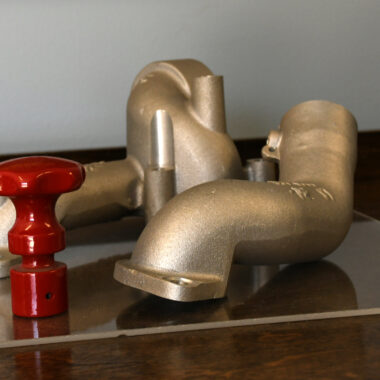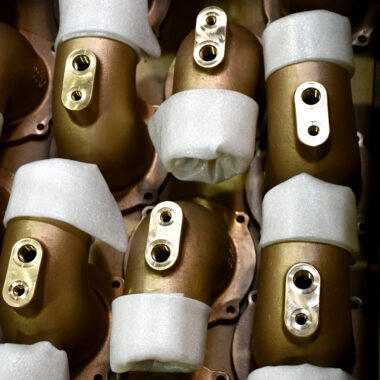Elevate Your Projects with Aluminum Casting Illinois: Let's Collaborate
Elevate Your Projects with Aluminum Casting Illinois: Let's Collaborate
Blog Article
The Ultimate Light Weight Aluminum Spreading Guidebook: Step-by-Step Recommendations for Success

Security Preventative Measures for Light Weight Aluminum Casting

Furthermore, maintaining a tidy work space devoid of mess can stop tripping risks and facilitate the activity of workers throughout casting processes. aluminum casting illinois. Proper training in handling molten aluminum and operating casting tools is necessary to minimize the threat of injuries and crashes. Normal equipment maintenance and inspection need to be carried out to recognize and correct any type of possible security hazards promptly
Establishing Your Light Weight Aluminum Casting Workspace
Developing a safe and reliable work area for aluminum casting is important for guaranteeing smooth procedures and lessening prospective hazards. Prior to establishing up your work area, ensure that it is well-ventilated to protect against the build-up of hazardous fumes generated throughout the casting procedure. It is necessary to have a marked area for each phase of the casting process, such as pattern production, mold prep work, and steel pouring, to improve workflow and protect against cross-contamination.
Choosing the Right Light Weight Aluminum Alloy
To guarantee optimum casting causes your safety-focused and well-organized office, choosing the proper light weight aluminum alloy is extremely important. Different light weight aluminum alloys offer different characteristics such as stamina, durability, warmth resistance, and machinability. The choice of alloy depends upon the details demands of your spreading project.
One typically used light weight aluminum alloy for spreading is A356. This alloy exhibits outstanding fluidness, making it excellent for intricate spreadings with slim wall surfaces. A356 also has great corrosion resistance and mechanical homes, making it ideal for a vast array of applications.
If greater stamina is needed, 7075 light weight aluminum alloy is a popular choice. Understood for its high strength-to-weight ratio, 7075 is usually used in applications where toughness is essential, such as aerospace components.
For projects that involve high-temperature environments, 319 aluminum alloy is an excellent option due to its exceptional thermal conductivity and resistance to thermal breaking.

Step-by-Step Aluminum Spreading Process
Beginning the aluminum casting process entails precise prep work and adherence to an accurate collection of actions to ensure the manufacturing of top quality spreadings. The first action is pattern production, where a reproduction of the end product is made from plastic, steel, or wood. This pattern is after that utilized to create the mold, which can be constructed from materials like sand or plaster. When the mold and mildew is prepared, it is time to melt the helpful site light weight aluminum in a heater at temperatures exceeding 1200 ° F.
After reaching the desired temperature, the molten light weight aluminum is put into the mold cavity. This action calls for care and precision to avoid issues in the last spreading.
Throughout the entire process, mindful surveillance and quality assurance measures need to be carried out to make sure the final light weight aluminum spreading fulfills the needed specifications and criteria.
Tips for Developing Your Casting Strategy
In refining your light weight aluminum casting strategy, careful attention to information and adherence to specific steps are paramount to ensuring the manufacturing of high-grade spreadings. One essential pointer for refining your spreading method is to very carefully prepare the mold and ensure it is clean and appropriately coated with a release representative to assist in the easy elimination of the spreading. Furthermore, keeping the aluminum at the appropriate temperature throughout the casting procedure is important for attaining optimal flow and lowering the danger of issues. An additional suggestion is to put the molten aluminum slowly and steadily browse around these guys right into the mold and mildew to avoid air entrapment and make certain a smooth fill. It is also essential to permit sufficient time for the light weight aluminum to strengthen entirely before eliminating the spreading from the mold and mildew. Ultimately, inspecting the casting for any type of blemishes and making needed adjustments to the process will certainly help Our site you improve and ideal your light weight aluminum spreading strategy with time.
Conclusion
Finally, adhering to correct security precautions, setting up a suitable work space, choosing the appropriate aluminum alloy, and faithfully complying with the step-by-step spreading process are vital for successful aluminum spreading. By taking note of these vital aspects and incorporating pointers to improve your method, you can achieve superb cause your light weight aluminum casting jobs.
From safety and security preventative measures to improving casting techniques, this handbook offers as a beacon of expertise for those venturing into the world of aluminum spreading.
Commencing the light weight aluminum casting process entails careful preparation and adherence to an exact collection of steps to make certain the production of high-grade castings.In refining your aluminum spreading method, thorough attention to detail and adherence to exact actions are critical to making certain the manufacturing of high-quality castings. One important suggestion for developing your casting method is to meticulously prepare the mold and ensure it is clean and properly covered with a release agent to help in the simple elimination of the spreading. Inspecting the casting for any type of blemishes and making essential adjustments to the process will assist you boost and perfect your aluminum casting method over time.
Report this page